Theory and Analysis:Sandbox Sequence
The Sandbox Sequence is a 2 minute 43 second long sequence of scenes from the End of Evangelion (specifically, Episode 26') that depicts a young Shinji in a playground with a sandbox. This sequence follows the cut where Rei asks Shinji what he wishes for while he is in the Entry Plug of Evangelion Unit-01. The vivid imagery from this sequence is often considered to be filled with symbolism and metaphors. This is one possible interpretation of the imagery and events of this sequence.
Summary
Leading up to this sequence, Shinji is in the Entry Plug and is asked what he wishes for. Without giving an answer (here we see a superimposed sketch of a woman's breasts) he starts wavering and turns into LCL. Then the drop of water, which is a visual cue that indicates a shift from the real world to "imaginary world" or vice versa. In this case, we're shifting from the real world (the Entry Plug) to the "imaginary" one (the Sandbox Sequence and following scenes).
At first, we see that everything is grainy, as if we're watching an old movie. As if to further push this motif, we see stage lights and what looks like a movie set. (The stage set is also used in Episode 25 and 26, as well as the practice room in Death.)
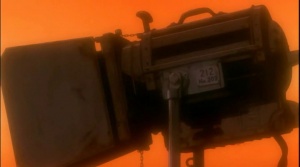
We see a swing set, swinging back and forth and the music starts, the music is almost carnivalish pipe organ sounding, playing the children's song ""Te o hiraite"[1]. In the background, we see hills that look very similar to a woman's breasts. There are 2 polls on either side of the hills, the left one is a loudspeaker and the right one is a street lamp.

We then see a zoomed out shot of the playground, we can see the swing, the hills, the surrounding trees and the sandbox itself. In the sandbox are Shinji and 2 other children. Here, we hear Shinji narrating, as if he is observing this scene: I see... It's just like when I started the cello. I thought that if I came here, I could find something...
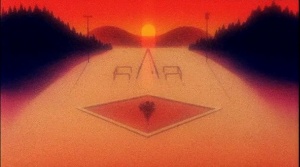
The camera then cuts to a shot of Shinji in the sandbox with a mound of sand (which looks like a destroyed pyramid) in front of him. Behind him, we can see 2 stage lights, appearing almost as they are eyes watching him. During the same shot, we hear some background music (Close hands, Open hands, a song Japanese children learn in Kindergarten) and you can hear 2 other children say to Shinji: Come on, Shinji!, Let's build a castle!. This instantly brightens his mood.
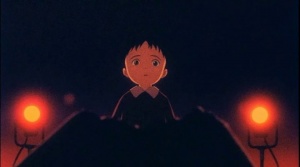

Shinji starts patting on the dirt with his hands, and the cut changes to the swing set, hills and setting sun (note that it is swinging faster). Then we see the 2 other children who Shinji is playing with. One has short black (possibly dark blue) hair and the other has red hair. Unlike Shinji, these 2 children look almost like dolls. They have exaggerated features such as large eyes, nose, and lips.
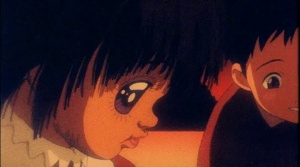
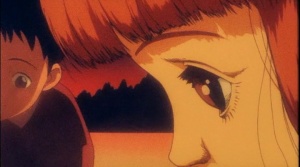
In the following cut, we see a woman - identified as Misato in the script[2][3] - dressed in an apron sitting on a folding chair and we hear the other 2 children say: Oh, here comes Mama!, We have to go home now!, Bye-bye!. There are other folding chairs scattered, almost randomly, on the movie set. The children leave Shinji alone again and he sits motionless, holding a clump of dirt in his hands.


The children can be seen leaving with their mother as Shinji remains motionless. You can hear the children saying "Mama" and laughing as they leave the movie set in the background, in contrast to the foreground, a lonely Shinji.
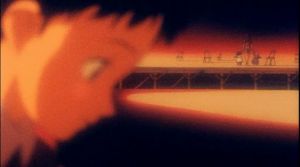
The scene cuts to a shot from below the stage looking up. You can see a small figure (Shinji[2]) looking to the other side, where the children and the mother were, unable to cross the chasm which separates them. Shinji remains there for a moment then leaves, returning to the sandbox.

When Shinji gets back to the sandbox, he is hunched over and in tears, sad and lonely. His eyebrows eventually stop twitching and he braces up, and starts to finish the sandcastle pyramid. He continues to sob as he pats the sand

The camera cuts back and slowly zooms out as we see Shinji alone, rebuilding the sandcastle pyramid, with the sun, the hills, and the swing in the background, now swinging very slowly and methodically. As Shinji continues, the streetlamp turns on, indicating that the sun is about to set.


Finally, Shinji is finished and he stands up, looking at the pyramid. He continues to stare as his eyebrows betray a bit of despondency and the background gets darker as the sun sets.
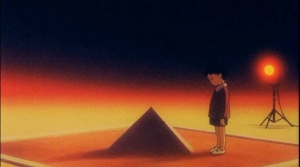
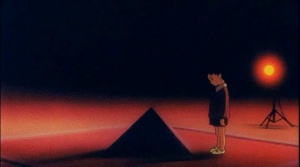
The darker background, indicating that his mood has changed from sad to angry, is followed by Shinji lifts his leg and starts kicking the pyramid apart. The camera then changes to the swing set, with the hills in the background and a sun just about to drop below the horizon. The swing slows and eventually comes to a stop. In the background, the sounds of Shinji still kicking the pyramid can be heard. The camera then cuts back to the pyramid destroyed by Shinji and crows caw in the background.
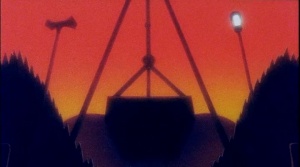

Another cut to Shinji looking down at his handiwork, with the hills and the stage lights in the background behind him. He seems to be contemplating what he had just done. After a few seconds, he goes back to rebuilding the pyramid that he just wrecked, occasionally wiping away tears with his sleeve and sobbing.
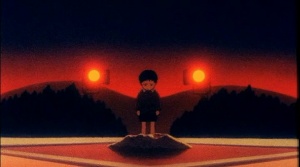
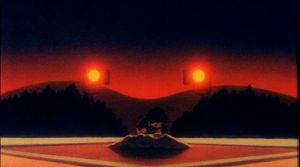
The sequence ends with a zoom out of the entire playground, Shinji is alone the sun has set. Before the sequence ends, you can hear Asuka shout: Jeeez! I get so pissed off whenever I look at you! Both a direct comment toward this pathetic Shinji in the Sandbox Sequence as well as a segue into the next sequence.
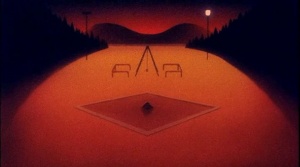
Analysis
"It's just like when I started the cello"
The only piece of narration we get in the entire sequence is Shinji saying I see... It's just like when I started the cello. I thought that if I came here, I could find something.... This brings us back to what he said about playing the cello in Episode 15
- Asuka: Not bad! I didn't know you played.
Shinji: I've been studying since I was five, and this is all I can do, so I don't really have any talent.
Asuka: Perseverance is power. I'm a little impressed.
Shinji: I started studying because my teacher told me to, so I could have quit anytime.
Asuka: Then why did you keep going?
Shinji: Because nobody told me to stop.
- Asuka: Not bad! I didn't know you played.
This indicates his attitude towards the cello, someone had told him to do it, he did it because he was told to, and he never stopped because nobody told him to stop. There is another line from Episode 26 where Shinji mentions the cello in the context of Shinji clinging to Eva because he lacks any purpose otherwise:
- Kaji: The Eva itself will become all you are.
Misato: The real you will cease to exist.
Shinji: I don't care! I never had anything to begin with anyway! Even the cello lessons I used to take all came to nothing.
Asuka: That's because you never took the initiative to make something of it!
Shinji: But I can pilot the Eva now!
Asuka: And eventually, you won't be able to do anything without the Eva. Like me.
Eye Catch: "Why do you pilot the Eva?"
Shinji: Because that is all I have.
- Kaji: The Eva itself will become all you are.
This is an important clue into interpreting the imagery in the Sandbox Sequence. Shinji is comparing his experience with Eva to his cello. Here, we have a similar case. Just like with the cello, Shinji goes to Tokyo-3 and Nerv because he was told to.
"I though that if I came here, I could find something"
Following the interpretation from the cello comparison, we can interpret the literal events in this sequence as relating to events that Shinji experienced since arriving at Nerv. In other words, the here is Tokyo-3 and Nerv.
- When Shinji shows up at Nerv (the pyramid), the 3rd Angel, Sachiel, has damaged Nerv. He's a little angry about his Father calling him here just because he had a use for him, but soon he starts to open up a little. He first meets Rei, then later he meets Asuka, both of which he considers his friends and co-workers ( symbolically, they're helping him (re)build the pyramid). Misato, who helps him open up a little, but who always seems a little emotionally distant to him, is also there. As he continues his stay in Tokyo 3, this illusion starts to fall apart, he feels as if his friends and guardian start distancing themselves from him and he feels unable to follow them. Shinji feels as if he's alone again, but this time he's a lot more upset than before he shows up in Tokyo-3. Shinji then decides to go to back to Nerv, but things don't get better and he loses it. At this point, Shinji is completely useless and alone, thinking that he has nothing.
The hills and the swing

In the image of the hills, the sun, and the swing set swinging back and forth. The hills are obviously imagery of a woman's breasts, possibly representing the mother, but the Sun in it's position, almost looks like a Core, possibly representing Shinji's mother, specifically Eva-01. The swing itself is in the foreground and swings back and forth. The swing can be heard creaking in the background and of varying speeds. One possible explanation of this is that it reflects that of Shinji's mood during the Sandbox Sequence. It swings faster when Shinji is content and happy, but slower when he is distressed or sad, until eventually, it stops completely. Arriving to the point that the swing stops, his friends have left him and he cannot follow them, distraught, he continues building the pyramid by himself. With it completed, he stares at it as the sun sets, then destroys it. After destroying the pyramid, the swing stops completely, and never starts swinging again.
The stage lights and the set

The stage lights throughout the sequence is commonly interpreted as being eyes. The first cut of the sequence tells us that these are stage lights, and not simply street lamps that are part of the playground (note that there is a street lamp in this sequence). Whereas the street lamp would be part of the "movie set", the stage lights are almost "observing" the set itself. It so happens, that nearly every time we see the stage lights, they look similar to a pair of eyes, watching Shinji. During these instances, they are always behind him and in some instances, it looks as if they belong to the hills. Connecting the eyes to the mother, it is possible that this represents Shinji's mother watching over him. To reinforce the notion that the stage lights are not part of the set, different angles and different shots of the playground sometimes have the stage lights in the shot, but others do not. For instance, you can clearly see that the stage lights are right behind Shinji, but when we zoom out, they are no longer there.
The set itself serves another purpose. It shows that this is not a flashback (at least not literally, although it is possible that this is a warped flashback of a childhood memory). This is an interpretation of something from within Shinji and he is observing it. His narrative first line in this sequence also backs this up. In another instance, the set is actually used to show the "uncrossable chasm" that separates the other children's mother, and later, the other children, from Shinji himself.
The other children and the mother

These are the other 2 children that are with Shinji in the sandbox building (or repairing) the sandcastle pyramid. They are doll-like, which makes them seem like representations of something within this movie set. They are more commonly said to represent, respectively, Rei and Asuka. These are the people who Shinji work with in protecting Nerv and Tokyo-3 and who he also sees as his friends. When the mother appears, which the script clearly states as being Misato, they suddenly appear next to her on the other side of the stage/movie set. The mother is also meant to represent something, since Misato isn't a mother, but represents the figure in which Shinji doesn't have and cannot attain. Shinji is stuck on his side of the movie set as the other children and mother happily leave.
There are also other interpretations where the first child seen is a representation of Shinji himself as a child. While this also makes sense, and some conclusions can be drawn from it, such as Misato is the one who provides a home for him and Asuka, the primary interpretation on this page will be from the point of view that this probably represents Rei.
The Sandcastle Pyramid
The Pyramid in the sandbox clearly reminds everyone of the Nerv Pyramid. Although this connection is pretty obvious, the sandcastle also serves to show Shinji's personality. He keeps building the pyramid because no one told him to stop. And it could be that when he finished, he realized that even though he accomplished something, there is no one around that cares about him to recognize it, so he destroys it in frustration.
Draft playground scene
The End of Evangelion drafts had a longer version of the sandbox sequence. The principal differences:
- There is only one girl mentioned, and it is suggested she be Asuka (with no Rei-doll):
"A young Shinji and a girl making a sand castle (in the shape of a pyramid?). (Make her a young Asuka?)"
- A brief glimpse of a young couple, which per the suggestion, has been cut from the final EoE
"Laughing, without a single glance at young Shinji, the girl goes back to her mother. For a moment, a young couple can be seen holding hands. (Is this necessary?)"
- At the end, there is not a "Jeeez! I get so pissed off whenever I look at you!", but rather, a parallel pair of flashbacks to Shinji and Asuka's childhoods in elementary school:
"Shinji as an elementary school student, alone, crying at his desk.
In the background, music and announcements indicating the end of the school day.
Voice of a male classmate: Tch, he's obsessed with himself, just because he lives at the teacher's place!
Voice of a female teacher: What a depressing child.
Voice of a female classmate: Such a nuisance!
Voice of a female classmate: He can't do anything by himself.""Asuka as an elementary school student, sitting alone at her desk.
In the background, the voices of children screaming as they play. (In German?)
Voice of a male classmate: Her tests are the most important [thing], so she can't say anything [to us].
Voice of Asuka as an elementary school student: I just don't talk away stupidly!
Voice of a male classmate: Pfft, that stuck-up, who do you think you are!?
Voice of Asuka as an elementary school student: What? I'm not the same as you!
Asuka's voice: Don't put me in with them!"
Notes
- The script indicates that Shinji is 3 to 5 years old in this sequence.
- Based on the ends of the hair in the sketch of the woman's breasts before Shinji turns to LCL, and the fact that Shinji sees Asuka's breasts several times in EoE, it can be inferred that what Shinji possibly "wishes for" is Asuka.
External Links
Discussion of the Sandbox Sequence: [1]
- ↑ Reichu attributes the song identification to "Keisuke-kun"
- ↑ 2.0 2.1 The production only mention Shinji just standing there [in pg 751 #185]. In addition, pg 750 #182 (the frame that shows a number of chairs with someone sitting in one of them) describes the person sitting there as Misato (half shaded, wearing an apron), and the next few frames state that it is Misato that the two little girls leave with." --Bochan_bird
- ↑ Reichu translates the script: "Cut to Shinji looking at dirt in his hands, he's motionless. The other 2 children are now with their mother (Misato), hand in hand, and appears to be walking away."
